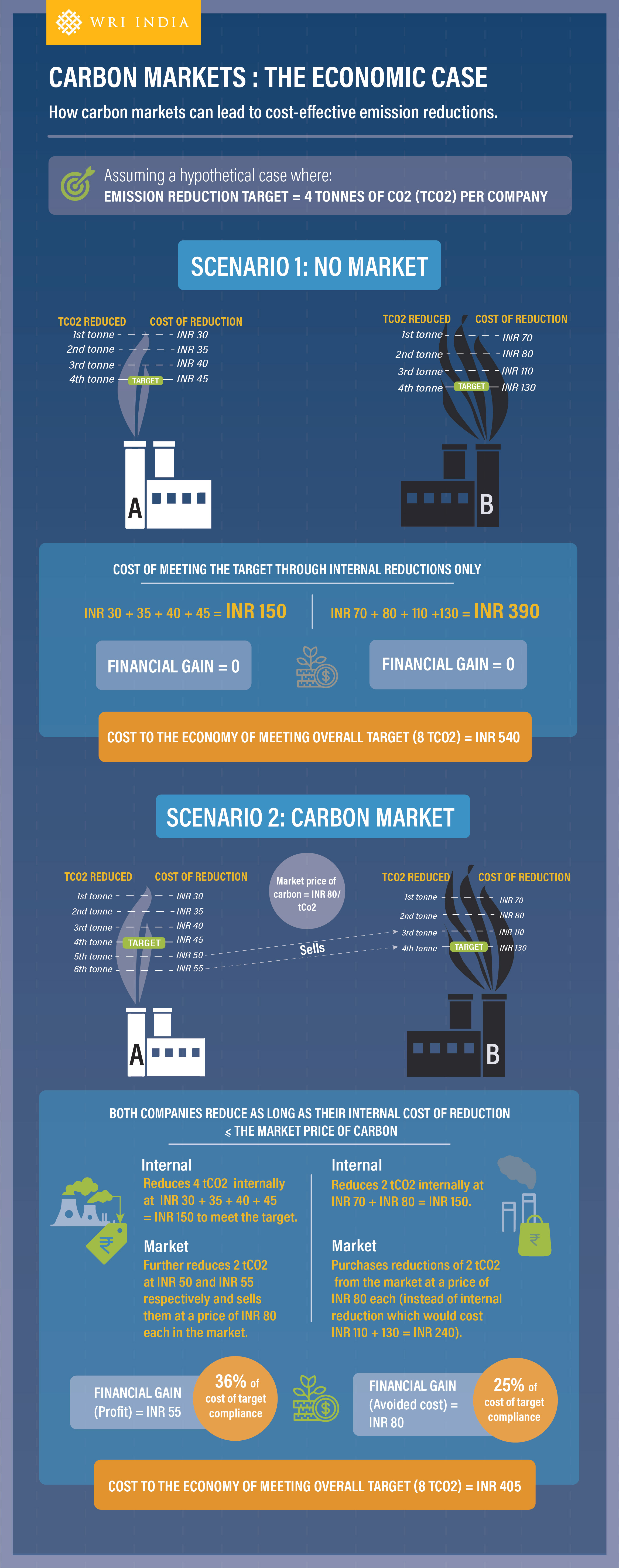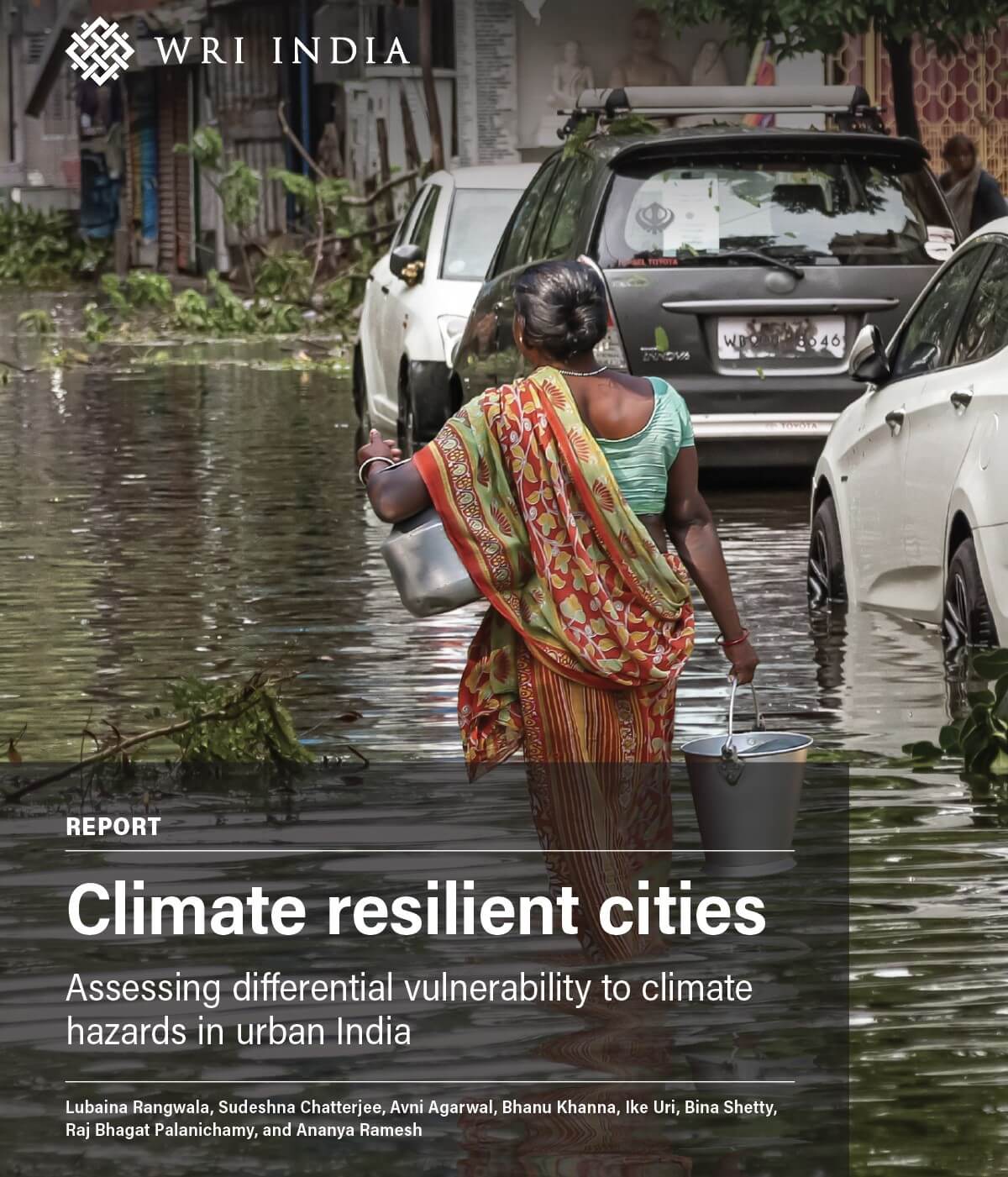Five Key Design Decisions for an Effective Carbon Market in India
by and -
Carbon markets are emerging as a popular choice for delivering cost-effective emissions reduction: 2021 witnessed the launch of national carbon markets in China and Britain. Trading in the British market opened last month at a carbon price of over 50 pounds per tonne, early prices indicating that polluters could face higher costs in Britain, as compared to the EU. In India too, late last year, the government constituted an interministerial committee to oversee the implementation of the Paris Agreement, including among its key functions the task of formulating guidelines on carbon pricing and carbon market mechanisms in the country.
A carbon market puts a cap or target on greenhouse gas (GHG) emissions. The cap is divided and allocated among regulated businesses in the form of emissions permits, and a market is created in which these permits can be traded. The trade is driven by the differing costs of reducing emissions among the regulated businesses, and lowers the total cost of achieving the emissions cap or target (see Figure 1).

Content & Design: Rhea Antony, Shubhangi Gupta and Ashwini Hingne.
The design of a carbon market involves making several choices. These choices have a direct impact on the effectiveness of the market to achieve the emissions reduction goal, as well as the costs to society and the trade-offs involved in doing so.
We reviewed carbon markets from around the world and identified five crucial design decisions for India:
- Market Coverage
One of the first questions to address in the context of carbon market design is that of coverage. Wider market coverage, e.g. by including more industrial sectors or regions, allows for more variation in the costs of emissions reduction among regulated businesses, and leads to larger efficiency gains from trading. However, a larger market can also mean higher transaction costs of participation, such as information and decision-making costs for firms, and monitoring and enforcement costs for the regulator. Such transaction costs can be disproportionately high for small businesses, outweighing the incremental efficiency gains from including them in the market.
This trade-off must be addressed in defining market coverage, and is one of the reasons most emissions trading schemes around the world, including the ongoing Perform Achieve Trade (PAT) energy trading scheme in India, restrict their coverage to businesses or sectors with emissions above a defined threshold. A well-designed market, however, should ensure market coverage is kept as wide as practically feasible, in order to maximize the potential gains from trade. - Target Setting
The next question is that of setting the right emissions cap or target for the market. The level of the emissions cap depends on climate change mitigation objectives, such as a country’s Nationally Determined Contribution (NDC) commitments, the emissions reduction potential in the covered sectors, and political feasibility. The cap can either set a limit on the total quantity of emissions or on the intensity of emissions per unit of GDP.
An intensity cap can allow total emissions to rise with GDP, and is often a popular choice with fast-growing economies. For instance, it has been used in China’s national emissions trading scheme (ETS). In India too, the ongoing PAT scheme has chosen intensity-based targets. The trade-off, however, is lower predictability of the change in total emissions, which can undermine the effectiveness of the market in meeting planned environmental objectives.
Another important consideration is to clearly define more ambitious targets over timeframes that are relevant to investment decisions. For example, the EU ETS has announced that its emissions cap will become stricter by 2.2% each year from 2021 to 2030. This gives regulated businesses a clear signal to shift investments toward low carbon technology. - Allocation Across Entities
Allocation deals with the question of distributing the emissions cap among regulated businesses. Tradable emissions permits equal to the capped amount may either be distributed for free or offered for sale through an auction.
Free allocation can be either grandfathered or benchmarked, as explained in Table-1. While grandfathering of past emissions is politically more acceptable, benchmarking rewards businesses that have already taken measures to reduce their emissions. It is also possible to adopt a combination of the two approaches, as done by the PAT scheme, which allocates sectoral targets among regulated entities taking into account their historical as well as relative performance compared to the best performing entity in the sector.
An alternative to free allocation is auctioning the emissions cap, which gives regulated businesses the opportunity to bid for emissions permits according to their anticipated needs via an auction. Moreover, this method also raises revenues for the regulator, which can be used to fund related policy objectives, compensate for any loss in competitiveness for regulated entities, or protect vulnerable sectors. The added cost of purchasing initial emissions quotas, however, can cause businesses to shift production (and hence their emissions) to jurisdictions with laxer emissions constraints, a phenomenon known as carbon leakage. The EU ETS, for example, which auctions permits, factors this risk into market design by allowing for free allocation to internationally competitive industrial sectors that are considered prone to carbon leakage.
Table 1: A Comparative Assessment of Free Allocation Methods Grandfathering Benchmarking Allocates permits to businesses in proportion to their historical emissions. Allocates permits to businesses in proportion to a sectoral performance benchmark. Penalizes first movers that have already reduced their emissions, creating a disincentive for early action. Encourages first movers by requiring smaller emissions cuts from businesses closer to the performance benchmark as compared to those further away from it. Simpler to implement and typically has higher stakeholder acceptability among the industry. Requires an understanding of industrial processes and the availability of related data to set performance benchmarks. - Incorporating Stability and Flexibility
Market design can also incorporate additional provisions to increase price predictability and flexibility of compliance for regulated businesses, which can enhance the political feasibility of the system.
Provisions to improve price predictability can include a price floor and/or a ceiling. Another form of price control is to maintain a reserve volume of permits, which may be introduced or withdrawn from the market by the regulator to manage price volatility. While a stable price signal can help businesses in planning long-term investments to reduce emissions, price controls can also lower the overall efficiency gains from trade by restricting transactions that would have otherwise taken place in a free market.
Features to provide greater flexibility of compliance include giving regulated businesses the option of banking unused emissions permits to use in future compliance periods as well as of borrowing permits from quotas allocated for future compliance periods. The trade-off in this case is reduced predictability in the timing of achievement of emissions reduction targets.
Another useful feature in this context is providing regulated businesses with the option of meeting a part of their target by buying emissions reduction credits from outside the market, known as offsets. The option of supplying such offsets can incentivize emissions reduction from sources that are not feasible to regulate directly within the market, such as micro, small and medium enterprises (MSMEs) in India, which contribute approximately 45% of the nation’s manufacturing output. The success of this feature, however, relies on the integrity of the allowed offsets, which means ensuring that offsets are generated from activities resulting in additional emissions reduction (over and above a defined business-as-usual scenario) and that each offset is used only once - in other words, there is no double counting. - Measurement, Reporting & Verification (MRV) of Outcomes
Finally, a carbon market needs a robust MRV system that ensures regulated businesses account and report emissions in a consistent, comparable, and transparent manner, along with clear enforcement provisions that include sufficient sanctions for non-compliance. A more comprehensive MRV system, however, can also increase the transaction costs of participating in the carbon market. Hence, it is important to keep reporting templates and verification procedures as simple and streamlined as practically feasible.
Given the implications of a carbon market for the industry and the array of choices, considerations and trade-offs involved in its design, the full implementation of such a scheme is almost always preceded by simulation exercises, small scale pilots, or learning-by-doing phases. These can help ensure stakeholder buy-in, build necessary capacity for participation, and make locally relevant and effective market design choices. WRI India’s Carbon Market Simulation, which brings together leading Indian businesses to participate in a mock emissions trading market, is a small step in this direction.
This is the third blog in a new series on carbon markets in India. In this blog series, we will share insights from WRI India’s corporate carbon market simulation in which more than 20 leading Indian companies participated during 2020-2021. Find the first blog here and the second blog here.


